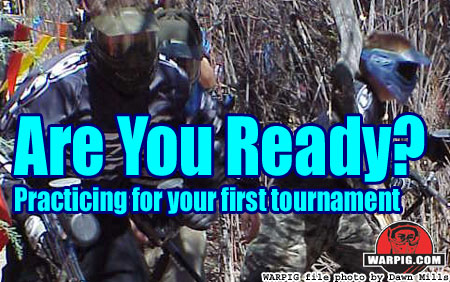  |
|
|
|
|
|
|
  |
|
|
|
|
|
|

What do you think? Add your comments in WARPIG's Forums
|

Are You Ready? Practicing for your FIRST paintball tournament Story and Photos by Robert Haselwander, UMR Paintball Club September, 2004 You have finally assembled the number of friends necessary to start your own paintball team, but now that you have a team you’re not really sure what to do with it. Naturally, one of your biggest concerns is going to be finding a tournament to play in, and working out all the logistics so your whole team can be at the tournament on time, ready to play. As important as all this is, there are critical things to consider long before you ever stand in a staging area, or have your back to the field, waiting while the ref counts down. There’s a single, proven path to playing well which is generally disliked, but is necessary for your team to play their best. What is it? Practice. Yes, the 5, 6, 7 . . . well, it might as well be a four letter word! Everyone has a bad practice memory from sports, but don’t let that stop you from practicing paintball. Practice is the key to victory; it will improve both your individual skills and your ability as a team. Best of all, it’s fun, because you’re still playing paintball!
As a new team, you can go to your local field and at least begin practicing and playing together by going to open play. This play together will help you become familiar with each other and it can be a good first step. Next, you might try to find another local team and setting up a scrimmage with them. Don’t be overawed the first time you play another team, it’s very possible that you won’t win the first time you play, but your team will improve, and that’s what really matters. The first time I set up a scrimmage with another team, my teammates were so intimidated by the other teams matching uniforms and guns that they were joking about shooting me off the break. It’s a difficult beginning step to take, but if you put the effort forth and actually scrimmage with another team before you go to a tournament you won’t have a reason to be intimidated at the tournament and most importantly, you’ll play better. Now that your team has started to play together and get a feel for each other’s strengths and weaknesses, it’s important to really focus on some of the nuts and bolts of play. One of the most important parts of playing as a team on the field is communication. Of course, the best way to build good communication is by playing and practicing together, and the longer you have played and practiced together, the better your communication will be. However, that doesn’t mean that there aren’t some things you can do to help improve your communication in practice. One drill that will help you improve your communication skills is a simple two on two game between members of your team.
There are some important things that your teammates will need to know when you’re on the field, and you’ll want to keep these things in mind. The most important things here are the simplest; you need to tell your teammates where your opponents are on the field, warn them when they’re about to get bunkered, and find out when you need to start laying cover fire. The best way to communicate these things is the original way, good old yell power, but you’ll have to practice them countless times before they are a fluid part of your game. So far we’ve covered some basic things that can make a big difference in your game and help your team do better in a tournament, but that isn’t the most important thing about paintball. Ultimately, win or lose, the most important thing about paintball is having fun; after all, none of us would be playing this if it wasn’t fun. A great way to keep this fun in practice is to include some fun drills just for relaxation. “The Gauntlet” is one such drill, which combines quick movement, quick shooting, and accuracy. It’s a fun break, from scrimmaging and it helps to develop snap shooting skills. The drill is very simple, all you need is some targets (empty soda bottles or old license plates work great) and a field to play on. Set up as many (or as few) targets as you want, behind bunkers, on top of bunkers, wherever, and then practice your shooting skills by running through with your gun, trying to hit as many targets as you can while you run. The idea is very simple, and you can even turn it into a competitive game among your teammates by timing everyone as they go through the course, to see who has the best time and the best score on hitting the targets. You can make the gauntlet more challenging by having your team captain or coach call out specific targets to shoot, like “Sprite!” or “California!” as you run up on a group of targets. This keeps the gauntlet from becoming repetitive and forces the player to keep listening to his or her team-mates while running and shooting. You can see the Ironmen make use of both The Gauntlet and scrimmaging on PigTV here.
|
| Copyright © 1992-2019
Corinthian Media Services. WARPIG's webmasters can be reached through our feedback form. All articles and images are copyrighted and may not be redistributed without the written permission of their original creators and Corinthian Media Services. The WARPIG paintball page is a collection of information and pointers to sources from around the internet and other locations. As such, Corinthian Media Services makes no claims to the trustworthiness or reliability of said information. The information contained in, and referenced by WARPIG, should not be used as a substitute for safety information from trained professionals in the paintball industry. |